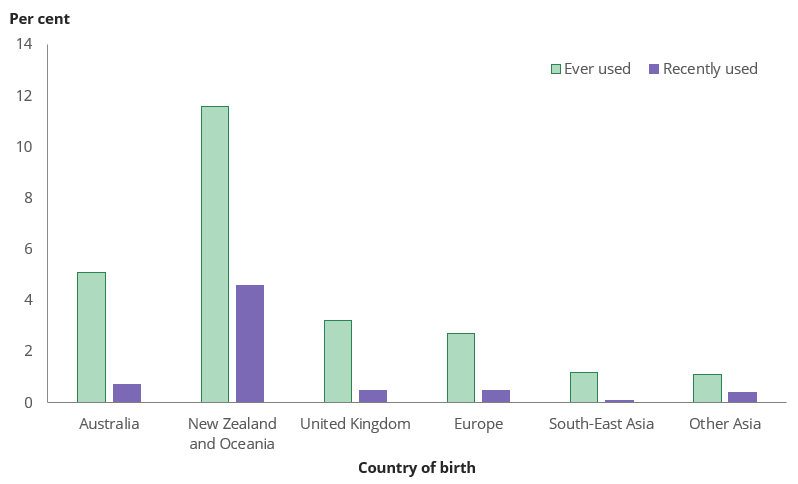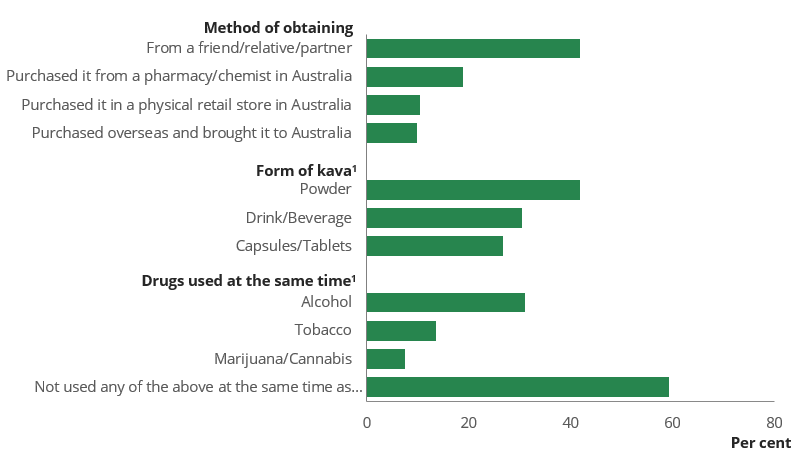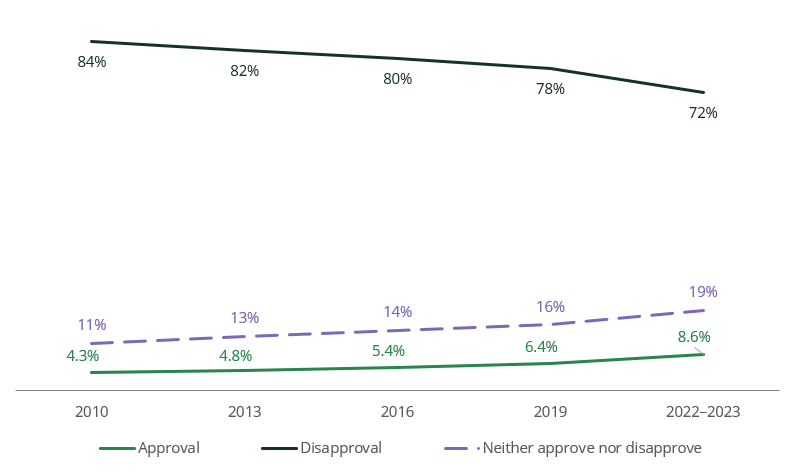What is kava?
Kava is made from the roots of the kava plant. It is grown and consumed across the Pacific Islands, and elsewhere, for ceremonial, recreational and medicinal purposes.
Kava tablets or capsules made with kava extract may be sold over-the-counter as treatment for anxiety, insomnia or stress (ADF 2023). However, this report does not focus on these forms of kava.
Importation of kava in Australia
As recognition of the cultural significance of kava for Pacific Island communities, the Australian Government has engaged in a pilot to make kava more accessible within Australia (DFAT 2023). This pilot has involved two phases:
- Increasing the amount of kava that people can bring into Australia with them (‘personal importation’) to 4kg. This phase began in December 2019.
- Allowing the ‘commercial importation’ of kava as a food into Australia. This phase began on 1 December 2021.
Kava use questions were included in the NDSHS for the first time in 2022–2023. Both phases of the kava pilot were active during the survey fieldwork period. Results should be interpreted in light of this pilot and the likely increased availability of kava during the pilot.
Not many people had kava in 2022–2023
In 2022–2023, less than 1 in 100 people (0.8% of the population) aged 14 and over had consumed kava in Australia in the previous 12 months. This means that even though kava was made readily available by the kava pilot, fewer people had used kava than many illicit drugs, including cocaine (4.5% of the population), hallucinogens (2.4%) and ketamine (1.4%).
Who was most likely to have recently had kava in Australia?
People in their 30s (1.2%) and 40s (1.3%) were the most likely to have consumed kava in Australia in the previous 12 months.
Unlike many other drugs both legal and illicit, use of kava did not differ greatly by socioeconomic area, remoteness area, or sexual orientation. However, there was one major difference: people born in New Zealand and Oceania excluding Australia were 6.6 times as likely as people born in Australia to have consumed kava in Australia in the past 12 months. Almost 1 in 20 people (4.6%) had done so, compared to the 0.7% of people born in Australia who had done so (Figure 1).
Additionally, 11.6% of people born in New Zealand and Oceania excluding Australia had ever consumed kava in Australia, more than double the proportion of people born in Australia (5.1%).

Source: NDSHS 2022–2023, Table 7.9.
Experiences of having kava in Australia
The NDSHS contains several questions which allow for a picture of how kava was obtained and used among people who had consumed it in Australia in the previous 12 months (Figure 2).

1. Respondents could select more than one response.
Source: NDSHS 2022–2023, Tables 7.5 to 7.7.
- Kava was most often obtained from a friend, relative or partner (42%), although a purchasing in a physical retail store (*10.4%) and personal importation (*9.7%) were common ways for people to obtain it themselves.
- Kava was most often obtained as a powder (42%), followed by a drink/beverage (30%).
- The majority of people who had consumed kava in Australia had not used any other drug at the same time (59%). However, 3 in 10 (31%) people who had consumed kava in Australia had consumed alcohol at the same time, and a small proportion (*7.4%) had used marijuana/cannabis at the same time.
* Estimate has a relative standard error between 25% and 50% and should be interpreted with caution.
Approval of regular kava use remains low, but increasing
While the NDSHS first asked about use of kava in 2022–2023, questions about people’s personal approval or disapproval of the regular use of kava have been included for many years.

Source: NDSHS 2022–2023, Table 11.10.
Approval of the regular use of kava increased between 2019 and 2022–2023 (Figure 3) but remained low, lower than some illicit drugs such as marijuana/cannabis (23%) and hallucinogens (9.5%). However, disapproval of regular use declined between 2019 and 2022–2023, with more people disapproving of the regular use of hallucinogens (74%) than the regular use of kava (72%).


